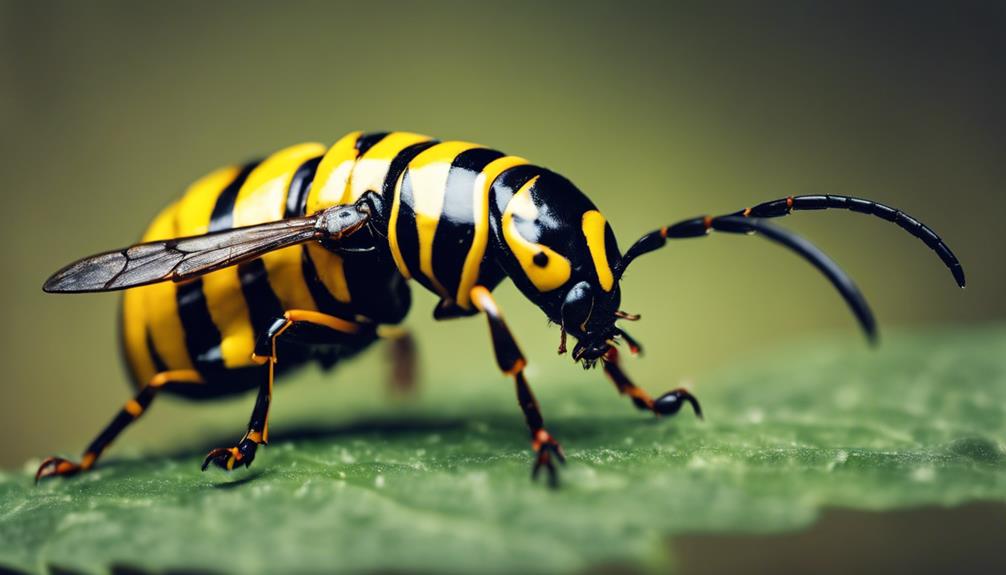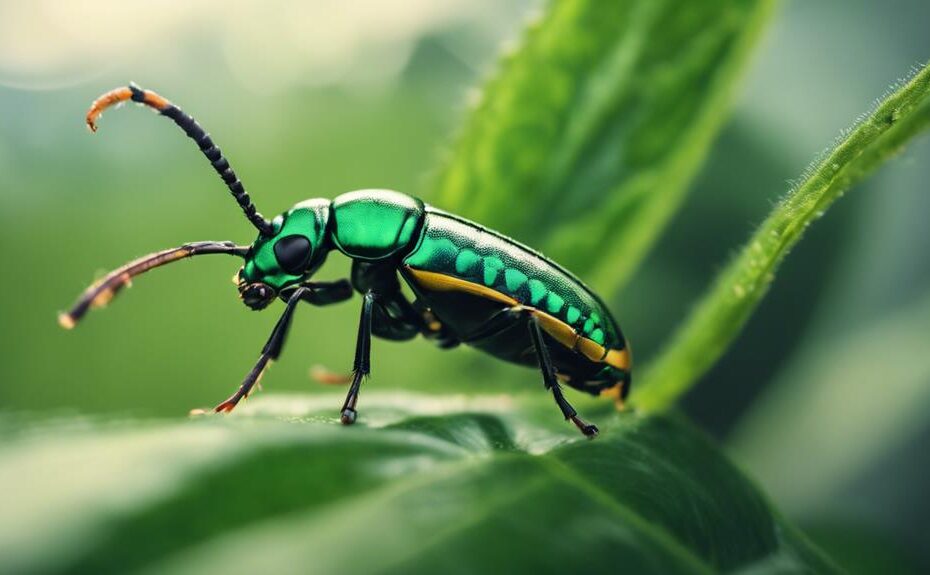The world of insects is teeming with fascinating creatures, and the wasp beetle is no exception. With its uncanny physical resemblance to wasps, this beetle often leaves observers intrigued by its mimicry.
However, there is more to this mysterious insect that meets the eye. From its intriguing lifecycle and behavior to its unique habitat and distribution, the world of the wasp beetle holds many secrets waiting to be uncovered.
Stay tuned as we uncover six intriguing facts about this enigmatic beetle that may surprise you.
Physical Resemblance to Wasps
With their black and yellow coloration and slender bodies, Wasp Beetles exhibit a striking physical resemblance to actual wasps, serving as a form of protective mimicry in the wild. This physical mimicry is an evolutionary advantage that aids in the beetle's survival by deterring potential predators who mistake them for stinging insects. The black and yellow stripes on the Wasp Beetle's exoskeleton closely resemble those of certain wasp species, creating a visual deterrent that warns predators of a potential threat.
This form of mimicry can be observed in various stages of the Wasp Beetle's life cycle, from larval to adult stages, indicating its importance in their survival strategy. By mimicking the appearance of a potentially harmful organism, Wasp Beetles reduce their risk of being attacked or eaten, thus increasing their chances of reproductive success and overall population survival. This evolutionary advantage highlights the intricate adaptations that have developed over time to ensure the Wasp Beetle's continued existence in diverse ecosystems.
Lifecycle and Behavior
The lifecycle and behavior of Wasp Beetles are intricately intertwined with their evolutionary adaptations, shaping their strategies for survival and reproduction in diverse ecosystems. These fascinating beetles undergo several distinct life stages, each playing a crucial role in their development and eventual mating behavior.
Wasp Beetle Lifecycle and Behavior
| Life Stage | Description | Duration |
|---|---|---|
| Egg | Laid by adult beetles in hidden crevices | 2-3 weeks |
| Larva | Feeds on decaying wood and plant matter | 1-2 years |
| Pupa | Metamorphosis from larva to adult beetle | 2-3 weeks |
| Adult | Emerges from pupa, ready for mating and feeding | Several weeks to months |
| Mating Behavior | Male beetles attract females through pheromones | Varies depending on species |
Understanding the lifecycle and behavior of Wasp Beetles provides insights into their ecological roles and the intricate mechanisms that have evolved over time to ensure their survival and successful reproduction.
Habitat and Distribution

Inhabiting a diverse range of ecosystems worldwide, Wasp Beetles demonstrate a remarkable adaptability to varying environmental conditions. These fascinating beetles can be found in various habitats, from woodlands and meadows to gardens and agricultural fields. Their distribution is influenced by factors such as climate, vegetation cover, and the availability of suitable hosts for their larvae.
- Environmental Impact: Wasp Beetles play a crucial role in their ecosystems by preying on other insects, thus helping to control pest populations and maintain ecological balance.
- Conservation Efforts: Due to habitat destruction and pesticide use, some species of Wasp Beetles are facing threats to their populations. Conservation efforts focus on preserving their natural habitats and raising awareness about the importance of these beneficial insects.
Climate change is also impacting the distribution and population trends of Wasp Beetles. As temperatures shift and habitats are altered, these beetles may face challenges in adapting to new environmental conditions. Understanding these dynamics is essential for implementing effective conservation strategies to ensure the continued presence of Wasp Beetles in our ecosystems.
Feeding Habits
Feeding behavior in Wasp Beetles showcases a diverse range of strategies tailored to their ecological niche and dietary requirements. These beetles primarily feed on nectar, pollen, and occasionally small insects. Their foraging strategies involve visiting flowers to obtain nectar and pollen, contributing to pollination in their habitat. Wasp Beetles are equipped with specialized mouthparts that allow them to efficiently extract nectar from flowers.
Predator avoidance is a crucial aspect of their feeding habits. To evade predators, Wasp Beetles often mimic the coloration and behavior of wasps, which are known for their defensive capabilities. This mimicry serves as a form of protective adaptation, deterring potential predators that may mistake them for stinging insects. Additionally, their bright coloration acts as a warning signal, alerting predators to their unpalatability or toxicity.
Predators and Defense Mechanisms

Wasp beetles face predation from birds, spiders, and some insects that prey on them during various life stages.
To defend against these predators, they utilize mimicry by resembling wasps, which deters potential threats due to the perceived danger associated with wasps.
Additionally, their bright warning coloration serves as an adaptation that signals to predators of their unpalatability, further enhancing their defense mechanisms.
Predators of Wasp Beetles
As predators play a crucial role in the ecosystem, it is essential to understand the various organisms that prey on Wasp Beetles and the defense mechanisms these beetles employ.
Wasp Beetle predators include birds, such as woodpeckers and nuthatches, which feed on adult beetles. Additionally, small mammals like shrews and rodents are known to consume both adult beetles and their larvae. Insects like spiders and predatory beetles also pose a threat to Wasp Beetles.
To defend against these predators, Wasp Beetles have developed protective mechanisms such as their wasp mimicry, which deters some predators due to its resemblance to stinging insects. These defense strategies help Wasp Beetles survive in their natural habitats despite the presence of numerous natural enemies.
Mimicry for Defense
In response to the diverse array of predators that pose a threat to Wasp Beetles, these beetles have evolved sophisticated mimicry mechanisms as a defense strategy in their natural habitats. This evolutionary advantage serves as a survival strategy, allowing Wasp Beetles to deceive potential threats through visual mimicry.
By mimicking the appearance of wasps, they deter predators that associate the black and yellow coloration with a stinging insect. Natural selection has favored this adaptation over time, as those beetles with more convincing mimicry patterns are more likely to survive and reproduce.
The intricate mimicry for defense exhibited by Wasp Beetles showcases the remarkable ways in which organisms have evolved to protect themselves against predation in their environment.
Warning Coloration Adaptations
Through the evolutionary process, Wasp Beetles have developed intricate warning coloration adaptations as part of their defense mechanisms against predators in their natural habitats. These adaptations provide evolutionary advantages and enhance their survival strategies.
Some of the key features of their warning coloration are:
- Bright Colors: Wasp Beetles exhibit vibrant yellow and black coloration, similar to wasps, warning predators of potential danger.
- Mimicry: They mimic the appearance of stinging insects like wasps, deterring predators that associate such colors with a painful sting.
- Distinct Patterns: The bold stripes and markings on their bodies serve as a visual warning signal, discouraging predators from attacking.
- Behavioral Cues: Wasp Beetles may exhibit certain behaviors, like hovering or jerky movements, further imitating wasps and reinforcing their warning coloration.
Significance in Ecosystem

Wasp beetles play a crucial role in the ecosystem by contributing to the pollination of various plant species, aiding in the reproduction of these plants.
Additionally, they serve as a food source for many predators, thus contributing to the biodiversity of their habitats.
The presence of wasp beetles in ecosystems helps maintain a delicate balance among different species, showcasing their significance in the natural world.
Ecosystem Role
Playing a crucial role in ecosystem dynamics, wasp beetles contribute significantly to the biodiversity and ecological balance of their habitats. These insects provide essential ecosystem services through their interactions with other organisms and the environment. Key points include:
- Pollination: Wasp beetles play a role in pollination by visiting flowers for nectar and pollen, aiding in the reproduction of various plant species.
- Predator-prey dynamics: They participate in population dynamics by preying on smaller insects, helping to control pest populations.
- Decomposition: Wasp beetles assist in the decomposition process by feeding on dead wood and assisting in nutrient recycling.
- Indicator species: Their presence or absence can indicate the overall health of an ecosystem, reflecting changes in environmental conditions.
Biodiversity Impact
Have the biodiversity impacts of wasp beetles been thoroughly studied in relation to their significance within the ecosystem?
Wasp beetles play a crucial role in ecosystem dynamics, particularly in terms of pollination and maintaining ecological balance. These beetles are effective pollinators, aiding in the reproduction of various plant species by transferring pollen from one flower to another. By doing so, they contribute to the diversity and abundance of plant life in their habitats.
Additionally, the presence of wasp beetles helps regulate insect populations, as they consume other insects, thus preventing potential outbreaks of certain species. Their interactions within the ecosystem demonstrate their importance in supporting biodiversity and overall ecosystem health.
Frequently Asked Questions
Are Wasp Beetles Harmful to Humans or Pets?
Wasp beetles are harmless to humans and pets as they do not sting or pose any direct threat. However, they mimic wasps to deter predators. Their resemblance to stinging insects helps them avoid being preyed upon by other animals.
Do Wasp Beetles Have Any Unique Mating Rituals or Behaviors?
Like a well-choreographed dance, Wasp Beetles engage in intricate mating rituals. These rituals involve specific courtship displays, such as intricate movements and pheromone signaling, essential for successful reproduction in these fascinating insects.
How Do Wasp Beetles Communicate With Each Other?
Wasp beetles communicate primarily through chemical signals, emitting pheromones to convey messages related to social interactions, mating, and territorial boundaries. Behavior patterns play a crucial role in their nesting habits, facilitating coordination and cooperation among individuals.
Can Wasp Beetles Be Kept as Pets or in Captivity?
Keeping wasp beetles in captivity can be intriguing. Through meticulous care and observation projects, enthusiasts can create enriching habitats. Providing suitable food, shelter, and monitoring their behavior can offer insights into these fascinating creatures' lives.
Are There Any Known Superstitions or Myths Surrounding Wasp Beetles in Different Cultures?
Cultural beliefs surrounding wasp beetles vary globally, with some cultures viewing them as symbols of protection or fertility, while others associate them with bad luck or death. Folklore often intertwines these insects with traditions and superstitions.
Conclusion
In conclusion, wasp beetles play a crucial role in ecosystems as pollinators. One study estimates that they can visit up to 200 flowers in a single day. Their physical resemblance to wasps serves as a form of mimicry to deter potential predators. Understanding their lifecycle, behavior, habitat, feeding habits, and defense mechanisms provides valuable insights into the intricate interactions within the natural world.
These fascinating insects contribute to the biodiversity and balance of ecosystems.

